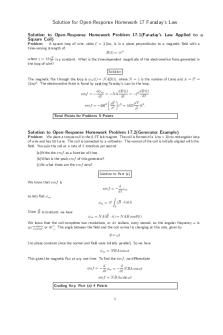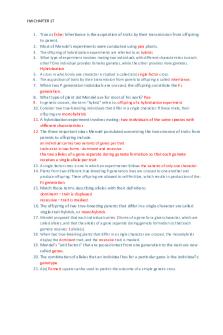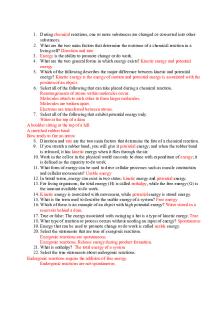Bio hw ch 17, Professor Vladimir Poltoratsky PDF

| Title | Bio hw ch 17, Professor Vladimir Poltoratsky |
|---|---|
| Course | Fund Of Bio Ii |
| Institution | St. John's University |
| Pages | 4 |
| File Size | 60.5 KB |
| File Type | |
| Total Downloads | 78 |
| Total Views | 144 |
Summary
Questions/answers of bio hw from chapter 17 with professor Vladimir Poltoratsky...
Description
HW CHAPTER 17 1. True or false: Inheritance is the acquisition of traits by their transmission from offspring
to parent. 2. Most of Mendel's experiments were conducted using pea plants. 3. The offspring of hybridization experiments are referred to as hybrids 4. What type of experiment involves mating two individuals with different characteristics to each other? One individual provides females gametes, while the other provides male gametes.
Hybridization 5. A cross in which only one character is studied is called a(n) single-factor cross. 6. The acquisition of traits by their transmission from parent to offspring is called inheritance.
7. When two P generation individuals are crossed, the offspring constitute the F1 generation. 8. What type of plant did Mendel use for most of his work? Pea 9. In genetic crosses, the term "hybrid" refers to: offspring of a hybridization experiment 10. Consider two true-breeding individuals that differ in a single character. If these mate, their offspring are monohybrids
11. A hybridization experiment involves mating: two individuals of the same species with different characteristics 12. The three important ideas Mendel postulated concerning the transmission of traits from parents to offspring include: an individual carries two variants of genes per trait traits exist in two forms - dominant and recessive
the two alleles of a gene separate during gamete formation so that each gamete receives a single allele per trait 13. A single-factor cross is one in which an experimenter follows the variants of only one character. 14. Plants from two different true-breeding P generation lines are crossed to one another and produce offspring. These offspring are allowed to self-fertilize, which results in production of the:
F2 generation 15. Match these terms describing alleles with their definitions
dominant – trait is displayed recessive – trait is masked 16. The offspring of two true-breeding parents that differ in a single character are called single-trait hybrids, or monohybrids. 17. Mendel proposed that each individual carries 2 forms of a gene for a given character, which are called alleles, and that the alleles of a gene separate during gamete formation so that each gamete receives 1 allele(s). 18. When two true-breeding plants that differ in a single character are crossed, the monohybrids display the dominant trait, and the recessive trait is masked. 19. Mendel's "unit factors" that are passed intact from one generation to the next are now
called genes. 20. The combination of alleles that an individual has for a particular gene is the individual's: genotype 21. A(n) Punnett square can be used to predict the outcome of a simple genetic cross.
HW CHAPTER 17 22. An individual with a dominant phenotype may be either homozygous or heterozygous. To determine the exact genotype of this individual a method called a(n) testcross can be used. 23. What is the modern term for Mendel's "unit factors" that are passed on intact from one
generation to the next? genes 24. A cross that follows the simultaneous inheritance of two different characters is called a(n) two-factor cross. 25. The term genotype describes the genetic composition of an individual for a particular gene. 26. The genetic material that resides within chromosomes is: DNA 27. After DNA replication in a heterozygote, the two sister chromatids on a single chromosome contain: identical alleles 28. Which of these is commonly used to predict the results of simple genetic crosses? Punnett square 29. The random alignment of chromosomes in meiosis I leads to the independent assortment of alleles on different chromosomes. 30. What is the purpose of a testcross? To determine the genotype of an individual with a dominant phenotype 31. A two-factor cross is one in which an experimenter follows the inheritance of two different characters. 32. A(n) pedigree analysis is the analysis of an inherited trait over several generations in one
family. 33. The genetic material of a cell is the DNA. 34. The limitations of pedigree analysis as compared to breeding experiments include: sample size too small 35. When a cell prepares to divide, the homologs replicate so that each homolog consists of a pair of sister chromatids. 36. Traits that appear in every generation and affect males and females exhibit: dominant
inheritance 37. Independent assortment of alleles of different genes can be explained by the random alignment of homologous pairs of chromatids during meiosis I. 38. What is represented in pedigree analysis? inheritance of an inherited trait over several generations in one family 39. Pedigree analysis is typically used for studying: human traits that follow simple Mendelian inheritance patterns 40. The results of pedigree analysis are less definitive than breeding experiments because the small size of human families results in: large sampling errors 41. Normal alleles become abnormal alleles through the process of mutation. 42. That two unaffected individuals can produce an affected offspring exhibits: recessive inheritance 43. Carriers of the cystic fibrosis allele are phenotypically: normal 44. Human traits that follow simple Mendelian patterns are usually studied using: pedigree analysis 45. In a pedigree, parents are connected to their offspring by: a vertical line 46. The difference between a normal allele and one that causes disease is the result of
mutation.
HW CHAPTER 17
47. The sex chromosomes refer to a distinctive pair of chromosomes that vary between male and female individuals. 48. Match each sex determination system with the correct factor that determines the sex of an individual. X-Y system - presence or absence of the Y chromosome X-O system - ratio between X chromosomes and autosome sets haplodiploid system - haploid or diploid set of chromosomes Z-W system - presence or absence of the W chromosome 49. The sex chromosome makeup of a human female is XX and the sex chromosome makeup of a male is XY. 50. True or false: Heterozygous carriers of the CFTR allele exhibit the symptoms of cystic
fibrosis. 51. In a pedigree, a female and a male who mate are connected by a(n) horizontal line. 52. The sex chromosomes are a pair of chromosomes that are different in males and females. 53. Genes found exclusively on the X chromosome are called: X-linked 54. Match each sex determination system with a representative species.
X-Y - human X-O – fruit fly Z-W - bird haplodiploid - bee environmental - alligator 55. The genotype of a human female is: XX 56. Genes found on one sex chromosome but not the other are called sex-linked genes. 57. Carriers of the cystic fibrosis allele are phenotypically: normal 58. Match the ways to denote individuals on a pedigree.
females - circles males - squares affected individuals - shaded unaffected individuals – not shaded presumed heterozygotes – half shaded 59. A trait that causes a disease will occur more frequently in males than females if the trait is recessive and X-linked 60. A gene found on the X chromosome and not on the y chromosome is designated as an X-linked gene. 61. What type of inheritance involves genes that segregate and assort independently? Mendelian inheritance 62. What type of allele is defined as the prevalent allele in a population? wild-type
63. Sex-linked genes are found on: one sex chromosome but not the other 64. Recessive X-linked alleles affect males more than females. 65. Incomplete dominance involves an intermediate phenotype in the heterozygote. 66. The pattern of inheritance that deals with genes that segregate and assort independently is described by the term Mendelian inheritance.
HW CHAPTER 17 67. The term multiple allele refers to the presence of three or more alleles in the
population. 68. For any given gene, the prevalent allele in a population is known as the wild-type allele. 69. True or false: When multiple alleles of a gene exist, each individual may inherit more
than two alleles. 70. The phenotypic range exhibited by individuals with a particular genotype under differing
environmental conditions is called the norm of reaction. 71. In an incomplete dominance pattern of inheritance, a heterozygous individual shows a(n) intermediate phenotype. 72. The critical element of Mendel's research focus was to use true-breeding strains that differed with regard to only one gene. 73. The term multiple alleles refers to the presence of 3 or more alleles in the population. 74. If a particular gene in a population has multiple alleles, how many alleles of that gene
will a diploid individual possess? 2 75. The pattern of inheritance in which the expression of one gene masks the expression of another gene is known as epistasis. 76. True or false: Most traits are influenced by one gene. 77. What is the norm of reaction? the phenotypic range displayed by individuals with a particular genotype under different environmental conditions 78. Mendel's laws of inheritance are used in family planning to uncover alleles in parents that may cause inherited disease in possible offspring. 79. Mendel's focus on single genes was pivotal in establishing the science of genetics because it allow Mendel to formulate basic laws of inheritance. 80. Epistasis is the pattern of inheritance in which: the alleles of one gene mask the expression of the alleles of another gene 81. The formula for a probability that a random event will have a specific outcome is equal to the number of times an event occurs divided by the: number of possible outcomes 82. Most, or perhaps all, traits are influenced by multiple gene(s).
83. Mendel's laws of inheritance are used in agriculture to develop commercially important crops livestock 84. What rule should be used to calculate the probability that independent events will occur together? The product rule 85. The chance that an event will have a particular outcome is called probability. 86. The appropriate time to use the product rule is when dealing with events that are:
independent...
Similar Free PDFs

HW Ch 1 - HW Ch 1
- 3 Pages

HW #17 - lol
- 2 Pages

BIO 210 Macromolecules HW
- 6 Pages

Bio hw 7 photosynthesis
- 4 Pages

Bio Chapter 17 Vocab
- 2 Pages

Solution OR Hwk (17) - OR HW 17
- 4 Pages

Chapter 17 - bio
- 18 Pages

Ch 5 hw - ch 5
- 10 Pages
Popular Institutions
- Tinajero National High School - Annex
- Politeknik Caltex Riau
- Yokohama City University
- SGT University
- University of Al-Qadisiyah
- Divine Word College of Vigan
- Techniek College Rotterdam
- Universidade de Santiago
- Universiti Teknologi MARA Cawangan Johor Kampus Pasir Gudang
- Poltekkes Kemenkes Yogyakarta
- Baguio City National High School
- Colegio san marcos
- preparatoria uno
- Centro de Bachillerato Tecnológico Industrial y de Servicios No. 107
- Dalian Maritime University
- Quang Trung Secondary School
- Colegio Tecnológico en Informática
- Corporación Regional de Educación Superior
- Grupo CEDVA
- Dar Al Uloom University
- Centro de Estudios Preuniversitarios de la Universidad Nacional de Ingeniería
- 上智大学
- Aakash International School, Nuna Majara
- San Felipe Neri Catholic School
- Kang Chiao International School - New Taipei City
- Misamis Occidental National High School
- Institución Educativa Escuela Normal Juan Ladrilleros
- Kolehiyo ng Pantukan
- Batanes State College
- Instituto Continental
- Sekolah Menengah Kejuruan Kesehatan Kaltara (Tarakan)
- Colegio de La Inmaculada Concepcion - Cebu







